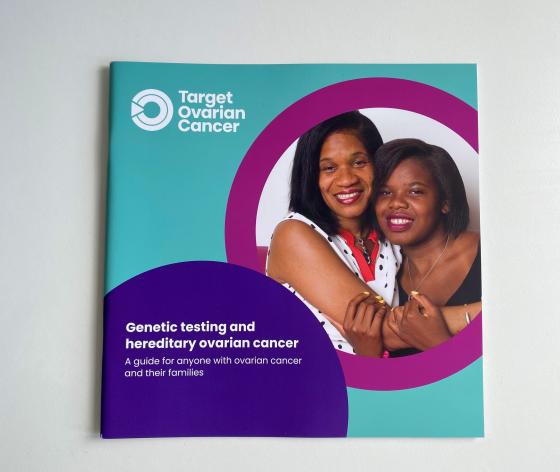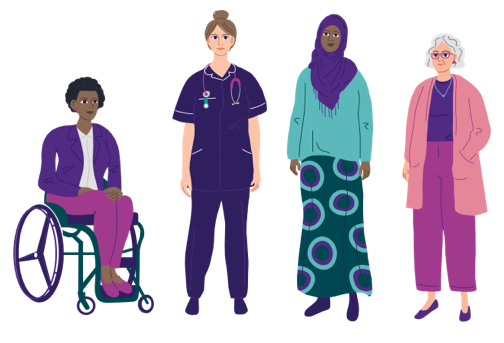Telling family members about a positive test result
If your test shows that you have a BRCA1 or BRCA2 gene variant ('variant present') it's possible that your relatives will also have a BRCA1 or BRCA2 variant.
Adult members of your family can choose to have a genetic test to find out if they have inherited the same gene variant. This is called predictive testing because a positive result ('variant present') for them means they have an increased risk of developing cancer. It doesn't mean they have cancer or are definitely going to develop it.
The variant in your BRCA1 or BRCA2 gene is likely to have been inherited from your mother or father. If they're unaware of their BRCA1 or BRCA2 status, they can access advice about testing, as can their siblings, nieces and nephews (your aunts, uncles and cousins).
Anyone who inherits a BRCA1 or BRCA2 variant, whether or not they develop cancer themselves, may pass the variant on to their children.
Not everyone with a BRCA1 or BRCA2 variant will develop cancer.
- What does this mean for my siblings?
-
Your full siblings (with the same mother and father) will have a 50 per cent (one in two) chance of also carrying the BRCA1 or BRCA2 gene variant and will be able to access predictive testing. The chance for half-siblings may be less than 50 per cent depending on family history, but they can still ask for predictive testing.
- What does this mean for my children?
-
Your children will also have a 50 per cent (one in two) chance of inheriting the BRCA1 or BRCA2 gene variant. Testing is only available to adults over the age of 18 because the risk management options are either not available or not yet necessary for those under 18. It's important that they make their own informed choice about whether or not to be tested.
How do I tell my family and how might they feel?
If your relatives are aware that you're having genetic testing, a conversation about the results may happen naturally. Depending on how you're feeling (physically and emotionally) it can feel like a difficult discussion to have. It can be particularly challenging if there are young family members you want to share the information with. You may struggle with the thought of maybe passing on a gene variant to your children.
All these feelings are completely normal so please remember you're not alone. You may find that talking to your partner, if you have one, or a friend can be helpful. Your local clinical genetics service is also available to provide support.
You may find that your relatives are wondering whether they have an increased cancer risk and are very accepting of the news about a gene variant. It means they're able to have a predictive genetic test and can take action if they're at increased risk.
Many people choose to have predictive genetic testing because they would rather be aware of an increased risk of cancer and manage or reduce the risk by having regular tests or even surgery (a risk-reducing operation). But knowing about a possible increased cancer risk may cause anxiety for relatives. Some people are concerned about the possible impact on their work and insurance. There's more information about this in our Genetic testing guide [PDF].
Some people are worried about the impact a possible increased cancer risk might have on future relationships and having children of their own. Help and support is available, including from your local clinical genetics service.
You may find you have relatives who are resistant to genetic testing and who would rather not receive the information. You may have relatives that you’re not in contact with. Your local clinical genetics service will be able to discuss this with you. If you think it will be helpful, they can provide an 'open letter' that you can send to relatives that explains about the gene variant and the genetic testing available to them.
Whether and when your relatives decide to have predictive genetic testing is up to them. Everyone's different and some adjust to the news quicker than others. You'll have given them an option that may not otherwise have been available to them.
Risk-reducing options
If a family member has predictive testing and has been found to carry a BRCA1 or BRCA2 gene variant, they will have had genetic counselling to discuss what this means for them and risk management options. In all cases, they will be supported in making decisions by a team of professionals.
More about managing an increased risk of breast cancer
Your family members may also want to consider these options for ovarian cancer:
- Removal of both of ovaries and fallopian tubes – bilateral salpingo-oophorectomy
-
Having surgery to remove the ovaries and fallopian tubes greatly reduces the risk of developing ovarian cancer. It may also slightly reduce the risk of breast cancer, although the evidence for this is unclear.
There's still a small remaining chance of developing primary peritoneal cancer which is treated in the same way as ovarian cancer. The peritoneum (a large, thin sheet of tissue that lines the organs in the tummy) can’t be removed during preventative surgery so this small risk remains. Removing the ovaries and the fallopian tubes is classed as major surgery.
If your family member hasn’t gone though the menopause before surgery, removal of both ovaries will cause the immediate start of the menopause. This is known as surgical menopause. If they’ve already gone through the menopause before surgery, they won’t experience surgical menopause.
Their medical team will discuss the advantages, disadvantages and risks of taking hormone replacement therapy (HRT) to manage the side effects of early menopause. HRT is usually recommended to reduce side effects from early menopause unless they've had breast cancer. Whether they're a BRCA1 or BRCA2 carrier or not, taking HRT until the recommended age of 51 doesn’t increase their risk of breast cancer.
- Surveillance
-
There’s currently no screening process for ovarian cancer. Risk-reducing surgery is the best way to manage the risk of developing ovarian cancer if your family member has a variant in their BRCA1 or BRCA2 gene. But many people choose not to have this operation straight away.
Some choose to wait because they want to have children, others may want to avoid early menopause and/or the symptoms related to menopause. Some people may not be well enough to have surgery and so want to wait until they’re feeling well and the operation is less of a risk.
- Contraceptive pill
-
Anyone who has ever used the oral contraceptive pill is much less likely to develop ovarian cancer than those who have never used it. Using the contraceptive pill can reduce the risk of developing ovarian cancer by as much as 50 per cent (one in two).
It’s not clear whether taking the contraceptive pill increases the risk of breast cancer in those with a BRCA variant. Some studies suggest an increased risk while others haven’t found this link.
If your family member is thinking of taking the oral contraceptive pill they should first discuss their options with their GP/breast team and/or genetic counsellor.
Family planning
A genetic counsellor will be able to provide more information to your family members about having children and the impact on the children they’ve had already.
The family planning options for people with a BRCA1 or BRCA2 variant are:
-
To have children without any intervention – each child would have a 50 per cent (one in two) chance of inheriting the variant.
-
To not to have children at all.
-
Adoption, where a child or siblings who can’t be brought up within their birth family become permanent legal members of a new family.
-
Egg or sperm donation, where eggs or sperm are collected from someone and given to someone else’s fertility treatment.
-
Pre-implantation genetic testing for monogenic disorders (PGT-M), which used to be called pre-implantation genetic diagnosis (PGD) – some couples may choose this option to avoid passing the BRCA variant to their children. PGT-M involves removing your eggs to fertilise with sperm in a test tube and creating embryos (IVF). When the embryos start growing but are still tiny (at a few days old), a cell is removed and is tested for the hereditary condition. Once the genetic status is determined, you can have an embryo that doesn’t have the condition put back to try to start a pregnancy.
-
Prenatal testing – some couples may choose to get pregnant naturally and have a test during the pregnancy to see if the baby has inherited the BRCA1 or BRCA2 variant. The couple could then decide whether to continue with the pregnancy. This isn’t a common request from couples at risk of passing on a risk of cancer that develops in adults.
Your family members may want to discuss their options with their geneticist who can explain the implications and the funding options available.
Insurance
An open-ended agreement is in place which guarantees that anyone who has had a predictive genetic test (for breast and ovarian cancer) can take out life and critical illness insurance cover without disclosing the results of the test. This agreement, known as the Code on Genetic Testing and Insurance, has been in place since October 2018.
Check the Association of British Insurers (ABI) for the latest guidance.
Genetic Alliance has more information about how to get insurance with a genetic condition.
Last reviewed: November 2022
To learn more about our review process, take a look at our information standards.



